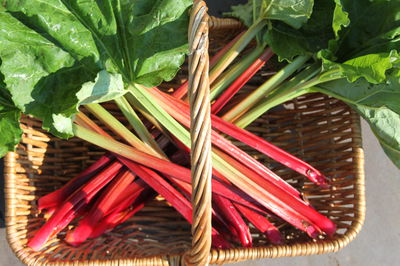 Nowadays, rhubarb varieties are again among the most popular plants in the kitchen garden. However, despite its predominantly sweet processing, rhubarb does not count as fruit but as a vegetable. Although the rhubarb varieties are still relatively new in our range, we have focused on the widest possible selection of varieties from the very beginning. Over the next few years, we will be able to supplement these with new varieties from the Lubera® breeding programme.
Nowadays, rhubarb varieties are again among the most popular plants in the kitchen garden. However, despite its predominantly sweet processing, rhubarb does not count as fruit but as a vegetable. Although the rhubarb varieties are still relatively new in our range, we have focused on the widest possible selection of varieties from the very beginning. Over the next few years, we will be able to supplement these with new varieties from the Lubera® breeding programme.
The red-fleshed rhubarb varieties at Lubera Edibles
The red-fleshed rhubarb varieties are said to have a slightly milder taste. This can be explained by a lower fruit acid content in the red-fleshed stalks.
- Canada Red is a variety of Canadian origin. The strong, medium-long stalks have a striking red colour on both the inside and outside, which remains even after processing. This is one of the reasons why this variety is also best suited for the production of rhubarb syrup. However, this variety is not only suitable for use in the kitchen, it is also convincing in the garden. 'Canada Red' is very undemanding, as it is a very vigorous variety with a high tolerance to frost. 'Canada Red' has been the strongest variety in our assortment up to now regarding the flesh and it is also evenly red-coloured very early on. Many other “red” varieties only slowly turn red inside the stalks in the course of the harvest period.
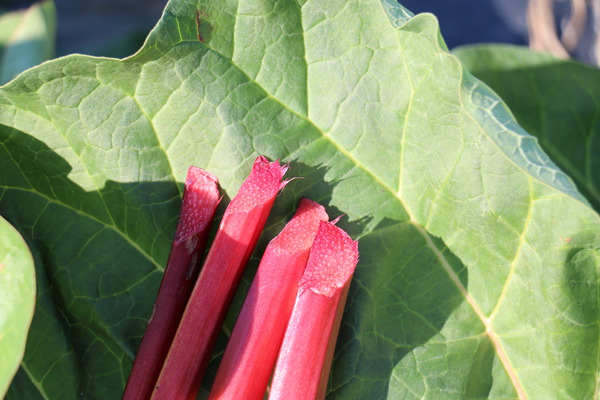
Picture: redfleshed rhubarb 'Canada Red'
- Elmsblitz is an old and proven variety, which we have revived. This variety has the lowest oxalic acid content of the classic but also of the red-fleshed varieties. This results in a very mild flavour and harvesting beyond 24 June is possible, but it should not be exaggerated.
The green-fleshed rhubarb varieties
The green-fleshed rhubarb varieties tend to have a higher yield than the red-fleshed varieties, but they have a higher acid content, at least in fruit acid. In addition, one should not be deceived by the fact that there are also green-fleshed varieties that have a red colour on the outside of the stalk.
- Fultons Strawberry Surprise has been awarded by the British Royal Horticultural Society (RHS) as currently the best variety in terms of flavour. Although the stalks glow in an intense red colour, it is still a green-fleshed variety with a slight hint of yellow.
Early rhubarb varieties
Some may wonder whether there is actually a difference between early and day-neutral rhubarb varieties. This difference definitely exists. Although the rhubarb varieties from both groups sprout similarly early in the spring, the everbearing ones tend to sprout a few days earlier, but the transition is quite fluent. The actual difference only becomes really clear in the summer, from 24 June. From this point on, the early varieties usually no longer form new leaves.
- Timperley Early is one of the earliest rhubarb varieties. Already with the first warm days after winter, this variety starts growing again, which is no problem, as it is very tolerant of late frosts. The stalks of 'Timperley Early' also have a red outer colour but are still green-fleshed.
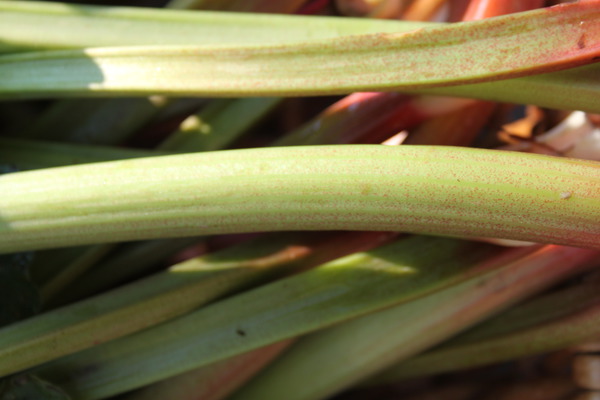
Picture: early rhubarb 'Timperley Early'
Everbearing rhubarb varieties
In contrast to the early rhubarb varieties, the everbearing rhubarb varieties continue to grow even after 24 June and form new leaves. These varieties can therefore still be harvested in the summer.
- Livingstone(S) is one of the first rhubarb varieties that can be harvested from spring to autumn, so it is sometimes advertised as an autumn rhubarb (similar to the autumn raspberries). The strong and long stalks have a greenish pink outer colour, with the strongest colour at the stem base. Otherwise the variety is green-fleshed with a hint of light pink.
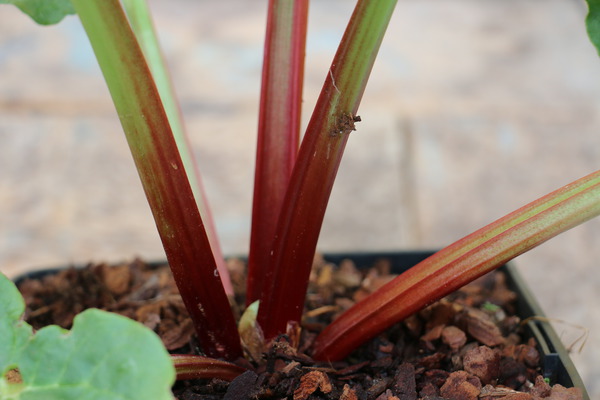
Picture: everbearing rhubarb 'Livingstone(S)'
Special rhubarb varieties
In addition to the classic vegetable rhubarb varieties, which produce a high yield with their strong stalks and are ideally suited for processing into desserts, special varieties can also be found again and again.
- Lilibarber® is a rhubarb through and through, but in miniature form. The leaves and petioles are no larger than 20 cm and the petioles are no stronger than the refill of a ballpoint pen. This makes 'Lilibarber'® more of a culinary herb than a vegetable plant. With this variety, both the leaves and the leaf stems can be eaten raw and they have the typical bitter/sour rhubarb flavour.
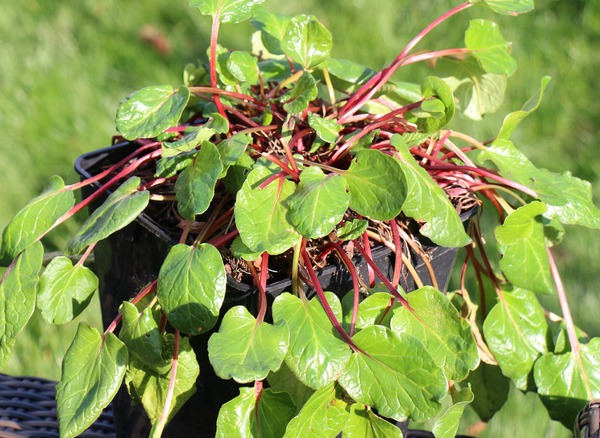
Picture: miniature rhubarb 'Lilibarber®'
What is coming next out of the Lubera® breeding programme?
In addition to our pome, stone and soft fruit breeding programmes, our sister company Lubera® also has its own rhubarb breeding programme. Currently, several thousand rhubarb young plants are waiting to be selected in the selection fields. This will enable us to supplement our assortment with our own varieties in both the short and medium term. We are already very far in the selection process for some varieties and are about to launch them onto the market.
Click here for more information.
Would you like more information, an individual consultation or information about additional ranges?
Click here for the complete 2019 catalogue, which can be downloaded.
If you have specific questions, please do not hesitate to contact our customer service, where you can also spontaneously place an order.
And of course we are always there for you via telephone.
If you want to be regularly informed about news, etc., you can also subscribe to our gardener newsletter here, which we send out about once a month - it's worth it!
